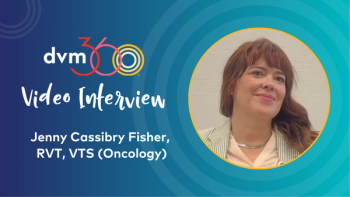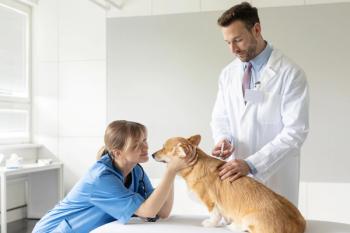
When doctor becomes patient
Seven years ago my mother and I saddled our horses for a relaxing trail ride. But as I swung my leg up to mount, something spooked my horse. He reared, threw me, flipped backwards, and crashed on top of me. My horse got up, but I didn't. My pelvis was broken in five places, I had ruptured blood vessels in my leg, and I would later sustain a life-threatening blood clot. In just an instant my life changed; doctor became patient.
By Kirsten Marek, DVM
Seven years ago my mother and I saddled our horses for a relaxing trail ride. But as I swung my leg up to mount, something spooked my horse. He reared, threw me, flipped backwards, and crashed on top of me. My horse got up, but I didnt. My pelvis was broken in five places, I had ruptured blood vessels in my leg, and I would later sustain a life-threatening blood clot. In just an instant my life changed; doctor became patient.
Ive never felt as helpless or as terrified as I did those first days in the hospital. Unable to move, I could do little besides wait for nurses and doctors to treat me kindlyor to forget my pain medication, handle me roughly, and speak harshly.
As veterinarians, we give orders and expect others to follow them: give these pills, take this radiograph. We issue diagnoses and assume clients will believe us. But as I lay in the hospital, I realized what my patients and clients went through when they entered my clinic. Being sick means losing control, and losing control is scary.
I cant change the fact that my patient becomes ill, but once hes in my hands, I can make his convalescence easier. Here are some lessons I brought home from my own hospitalization:
1. Stop the pain.
Pain degrades and debilitates. It robs you of the ability to think and function. Researchers describe the wind-up phenomenon in which pain-stimulated nerves become hypersensitive, eventually feeling pain at even the slightest touch. I believe that this process goes one step further. After a few painful experiences (and with a fractured pelvis, just shifting positions hurts), my brain went into wind-up, fearing every time the nurses entered the room. My body tensed, my heart raced, and I thought, No, dont touch me. But once I knew my pain was controlled, I relaxed.
Our clients worry that their pets feel pain. We have powerful and safe analgesics that can ease almost any discomfort. Theres no excuse not to use them.
2. Support the family.
While I lay in drug-induced bliss undergoing an MRI, my mother sat alone in the ER waiting room. Shed just witnessed a horrible accident, and she didnt know the extent of my injuries. Theres nothing more terrifying than watching a loved one lie sick, all fate in the hands of the doctor. Family members suffer feelings of guiltdid I cause this to happen?mixed with feelings of anguishI cant bear to see him suffer this way!and, worst of all, trepidationdoes this doctor know what hes doing? Will he be kind? What if hes wrong? How will I even know? The grieving person feels completely out of control.
While the doctors ran tests on me, a hospital priest sat with my mother. I dont know what they talked about. I do know that the simple gesture comforted my mother. Few practices can afford their own grief counselor. But anyonea receptionist, a kennel assistantcan offer a worried owner support. You dont need to offer specific information on a pets condition. Just saying, I care, and youre not alone, helps. Reassure the frightened client that his or her pet is in good hands. Update the client about when he or she will be able to see the pet or when the doctor will be free to talk. Let clients know theyre not forgotten, and they will feel more in control.
3. Allow visits.
That first night in ICU, the hospital staff members allowed my husband to visit me for 15-minute intervals. I rested much easier with Dan beside me. I also required less morphine. Now I encourage pet owners to visit their hospitalized pets. It may be the only time a human touch doesnt bring with it a needle, a pill, or some other invasion.
More important, allowing clients to visit their pets allows them to take part in their pets treatments. They see that the pets clean and comfortable and that were carrying out the discussed treatments. The visits comfort both the client and pet, and they offer the client some control over whats happening to his or her pet.
4. Inform the client.
A day after my injury, I couldnt move my feet. The doctor told me I hadnt injured my spinal cord, but my paralysis scared me. When I asked my doctor if this was normal after such an injury, he turned away, seeming not to hear. He left me feeling confused, doubtful, andagainhelpless.
How many times do we ignore clients questions and fears, or answer with some important-sounding medical language that leaves the client more confused? Experience tells me that clients want to know, first and foremost: Is my pet in pain? And is he going to recover? I try to answer these questions first, then I cover disease pathology in more detail. Because frightened clients probably wont hear or retain what I discuss in the exam room, our hospital always provides detailed handouts, including copies from veterinary journals or textbook articles.
In todays info-mania age, clients will seek answers on the Internet if we dont provide them. Why? Clients need to feel empowered. When clients know why were choosing the diagnostics and medications and what to expect from them, theyre more likely to comply with our recommendations.
5. Healing takes time.
Two months after my injury, I returned to work. But I was plagued by fatigue. Months after I thought I should have felt better, I still slept excessively and had little energy for family activities. I felt betrayed by my body. But when I mentioned my concerns to my physician, he ignored my fears. Hed solved my orthopedic problemshis job was done.
Of course, I realize now that although I looked healed, my body was rebuilding damaged bone and muscle. Small wonder I tired easily! Now, when a client expresses worry that his or her pet still isnt itself, I tell about my own experiences and try to reassure the pet owner. Illness or injury is a huge shock to our system. When a pet bounces around days after a bout of pancreatitis, we should be amazed, not take it as the norm.
Injury and illness are fraught with uncertainty, and this uncertainty can be more stressful than the disease. Medicine has long suffered a cold and secretive reputation, seen as a skill thats practiced behind closed doors by societys elite. We need to open those doors and return some of the control that a pets illness has robbed from our clients.
Sure, giving power to the client robs us of autonomy. Explaining disease to a confused client, allowing family visits, and printing client handouts all take time. But it also makes us better doctors. And seeing a satisfied client with a healthy pet is the best power rush of all.
Newsletter
From exam room tips to practice management insights, get trusted veterinary news delivered straight to your inbox—subscribe to dvm360.





